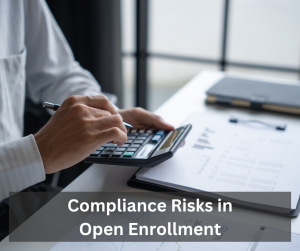
by admin | Nov 12, 2025 | Employee Benefits, Hot Topics
 Federal regulators—specifically, the Departments of Labor, Health and Human Services, and the Treasury—issued joint guidance on October 16, 2025, making it significantly easier for employers to offer fertility benefits outside of their traditional group health plans.
Federal regulators—specifically, the Departments of Labor, Health and Human Services, and the Treasury—issued joint guidance on October 16, 2025, making it significantly easier for employers to offer fertility benefits outside of their traditional group health plans.
This action was driven by an Executive Order focused on protecting in vitro fertilization (IVF) access and reducing the high out-of-pocket costs associated with fertility treatment. The guidance effectively creates compliant pathways for employers to offer fertility coverage as an excepted benefit.
Key Takeaways for Offering Fertility Coverage
The new guidance provides clear, compliant options for employers to offer fertility support:
- Standalone Excepted Benefit: Employers may offer fertility benefits through a separate, fully insured policy that is not coordinated with the main group health plan. This is a crucial distinction, as individuals enrolled in this separate coverage may still contribute to a Health Savings Account (HSA).
- Excepted Benefit HRA: Employers can use an Excepted Benefit Health Reimbursement Arrangement (HRA) to reimburse employees for out-of-pocket fertility expenses, provided the HRA meets all applicable regulatory standards.
- Limited EAP Services: Benefits for fertility coaching and navigator services (to help employees understand their options) can be offered under an Employee Assistance Program (EAP), as long as the EAP qualifies as a limited excepted benefit and does not offer significant medical care benefits.
What’s Next?
The Departments have indicated they plan to release future rulemaking to explore even more ways to offer fertility benefits as a limited excepted benefit, which could offer employers additional flexibility in the future.

by admin | Nov 4, 2025 | Custom Content, Employee Benefits, Health & Wellness
 The future of healthcare is rapidly evolving, with a clear trend toward integrating health interventions directly into employee benefits packages. As employers face rising healthcare costs—projected to increase by over 8% in 2025—they are rethinking how to deliver value to their workforce while managing expenses. This integration is reshaping not just what benefits are offered, but how employees access, use, and experience healthcare.
The future of healthcare is rapidly evolving, with a clear trend toward integrating health interventions directly into employee benefits packages. As employers face rising healthcare costs—projected to increase by over 8% in 2025—they are rethinking how to deliver value to their workforce while managing expenses. This integration is reshaping not just what benefits are offered, but how employees access, use, and experience healthcare.
From Reactive to Proactive: A Paradigm Shift
Historically, employee benefits have largely been reactive, focusing on covering costs after an illness or injury occurs. While essential, this model often overlooks the power of prevention, early intervention, and continuous support. The modern workforce, increasingly diverse in its needs and health goals, demands more. They seek benefits that empower them to manage their health proactively, rather than merely responding to sickness.
Integrating health interventions directly into benefits packages represents a pivotal move towards a proactive, holistic model. This means weaving in tools and programs that actively promote wellness, manage chronic conditions, and address the root causes of health challenges before they escalate.
What Do “Integrated Health Interventions” Look Like?
This new era of benefits goes beyond basic wellness programs. It encompasses a wide array of specialized, often technology-driven, interventions designed to meet specific health needs:
- Personalized Digital Health Platforms: These platforms leverage AI and data to offer tailored recommendations for fitness, nutrition, sleep, and stress management. They can connect employees with virtual coaching, mental health resources, and even provide smart device integration for continuous health monitoring.
- Specialized Chronic Condition Management Programs: For employees managing conditions like diabetes, hypertension, or asthma, integrated benefits offer dedicated support. This might include virtual health coaching, remote monitoring devices, personalized nutrition plans, and direct access to specialists, all aimed at improving adherence, outcomes, and quality of life.
- Mental Health & Well-Being Solutions: Recognizing the escalating importance of mental health, benefits packages are increasingly including access to online therapy platforms, meditation apps, stress reduction programs, and resilience training. These are often integrated with EAPs (Employee Assistance Programs) for a comprehensive support system.
- Preventive Care & Early Detection Initiatives: Beyond standard physicals, this could involve access to advanced health screenings, genetic testing (with proper counseling), smoking cessation programs, and vaccination clinics, all designed to identify risks early and prevent disease.
- Family-Building & Parental Support: Expanding beyond traditional maternity benefits, interventions now include fertility support, adoption assistance, lactation consulting, and comprehensive parental leave policies, acknowledging the full spectrum of family health needs.
The Multi-Layered Benefits of Integration
For employers, the strategic integration of health interventions yields substantial advantages:
- Improved Employee Health Outcomes: Proactive management leads to healthier employees, reducing the incidence and severity of chronic conditions.
- Reduced Healthcare Costs: Early intervention and better management of health issues can significantly lower claims costs, emergency room visits, and long-term medical expenses.
- Enhanced Talent Attraction & Retention: A comprehensive, forward-thinking benefits package is a powerful differentiator in a competitive job market, signaling a true investment in employee well-being.
- Increased Productivity & Engagement: Healthier, less stressed employees are more focused, engaged, and productive, leading to a more vibrant workplace culture.
- Stronger Organizational Culture: Prioritizing employee health fosters a culture of care, support, and appreciation, boosting morale and loyalty.
Challenges and the Path Forward
While the benefits are compelling, integration comes with its challenges, including data privacy concerns, ensuring equitable access, and effectively communicating complex offerings. The future of healthcare within employee benefits is not just about providing access to care, but about actively cultivating health. By seamlessly weaving targeted health interventions into benefits strategies, organizations can build a healthier, more resilient workforce, ultimately contributing to a more sustainable and prosperous business.

by admin | Oct 30, 2025 | Custom Content, Employee Benefits, Health Care Costs
 No doubt about it, prescriptions are expensive. While this may not be a big worry when you’re young and healthy, the costs can add up quickly if you’re diagnosed with a chronic condition or need an expensive drug. Whether you take medications regularly or for an occasional illness, it pays to know how to save money on prescriptions.
No doubt about it, prescriptions are expensive. While this may not be a big worry when you’re young and healthy, the costs can add up quickly if you’re diagnosed with a chronic condition or need an expensive drug. Whether you take medications regularly or for an occasional illness, it pays to know how to save money on prescriptions.
Did You Know?
Drug costs are a primary driver of rising healthcare expenses for both employers and employees. Prescription drug spending is consistently growing at a faster rate than overall healthcare costs, with a steady increase of 6.8%. As the fastest-growing part of benefits plans, these costs will continue to climb with new pharmaceutical innovations.
For years in the U.S., cost has been a significant obstacle to sticking with medications with up to 3 in 10 people reporting that they do not take their medications as prescribed.
The Rising Cost of Prescriptions
Historically, prescription drug costs have outpaced total healthcare costs. The following chart highlights this trend from 2019 to 2024. 
Prescription drug costs can put a strain on your budget, but with a little research and the right questions, you can reduce expenses without sacrificing your health.
Here are expert-backed strategies to help you save on your medications:
-
-
- Ask About a Generic Drug – Get the same quality and active ingredient as you’d find in a brand name, for less money.
- Save Money with a Pill Splitter – If your prescription comes in a higher dose that can be safely split, you get 2 doses for the price of 1.
- Consider a Combo Pill – Combining two drugs into one pill can help you avoid paying separate copays or coinsurance. Ask if a combo pill is an option for you.
- Buy in Bulk – Opt for a mail-order pharmacy to get a 90-day supply of your meds instead or a 30-day supply. This can often reduce your copay and overall cost.
- Make a List and Check it Twice – Check the list of preferred medications (a.k.a. “the formulary”), which tend to cost less.
- Find Out if You Still Need That Medication – If you’ve been taking the same medication for years, it’s worth checking in with your doctor to see if you still need it. Or if you’ve made a lifestyle change, it may reduce your need for certain medications. It never hurts to ask your doctor.
-
-
-
-
-
The medicines prescribed by your doctor are essential to your good health. With some savvy shopping, you can use the money you save on the things you enjoy!

by admin | Oct 21, 2025 | Employee Benefits, Open Enrollment
 Open enrollment is a hectic and critical period for employers that often brings a risk of compliance errors. These mistakes can confuse employees and cause missed benefits, while also exposing employers to legal risks.
Open enrollment is a hectic and critical period for employers that often brings a risk of compliance errors. These mistakes can confuse employees and cause missed benefits, while also exposing employers to legal risks.
This article highlights five common compliance pitfalls to avoid during open enrollment:
- Ineffective Communication of Benefit Changes – Benefit offerings often change annually due to plan design updates or regulatory mandates. Employers must clearly notify employees of any changes, including cost-sharing adjustments and new benefits, well before open enrollment. Using multiple communication channels and simple explanations helps employees make informed choices. Updates should also be reflected in required plan documents like the Summary Plan Description (SPD) or Summary of Material Modifications (SMM).
- Overlooking Election Deadlines
– Open enrollment periods should end well before the new plan year to allow orderly processing and compliance with tax laws. Employees’ benefit elections under Section 125 cafeteria plans are typically irrevocable for the plan year unless a qualifying life event occurs. Clear communication and encouraging early enrollment help prevent late or mistaken elections, which are difficult to correct.
- Failing to Distribute Required Health Plan Notices
– Employers must provide various health plan notices during open enrollment, such as the Summary of Benefits and Coverage (SBC), COBRA notices, CHIP notices, WHCRA notices, Medicare Part D disclosures, and HIPAA privacy notices. These notices ensure employees are informed of their rights and plan details and must be delivered in timely fashion. Electronic delivery is often permitted with proper safeguards.
- Not Providing Materials to All Eligible Individuals – It’s crucial to distribute open enrollment information not only to active employees but also to eligible individuals on leave, furlough, or COBRA continuation. A multi-channel approach with diligent tracking of distribution reduces the risk of missed communications and potential disputes.
- Neglecting Disclosure of Reasonable Alternatives in Wellness Programs – Wellness programs that impose surcharges or provide rewards based on health standards must offer reasonable alternative ways to meet requirements, per HIPAA rules. Employers need to disclose these alternative standards and provide contact information and assurance that personal physician recommendations will be accommodated. Compliance reduces legal risks related to premium surcharges and discrimination claims.
By proactively addressing these areas, employers can help employees confidently choose benefits while reducing compliance risks and administrative challenges.
by admin | Oct 7, 2025 | Custom Content, Employee Benefits
Health Insurance today is significantly more complex for young workers than it was just a decade ago. This complexity is driven in large part by healthcare costs that have outpaced inflation, pushing premiums, copays, and other out-of-pocket expenses to comprise substantial portions of their budgets. For many younger employees, navigating this landscape is confusing – more than 50% of Gen Z and Millennial workers admit to randomly selecting a health insurance plan, and nearly half say they don’t know where to turn for help during open enrollment. This lack of guidance makes it difficult for them to anticipate costs and make informed decisions about their care.
They also don’t truly grasp basic health insurance terms like “premium” or “deductible.” This knowledge gap doesn’t just confuse employees; it costs businesses an estimated $106 billion to $238 billion annually due to poor health literacy.
The good news? We can turn the tide. Empowering employees to become smarter benefits consumers pays off for everyone, leading to better health outcomes and lower costs. The earlier this education begins, the greater the impact. Here are five practical strategies for helping young employees get up to speed on their benefits:
- Begin with the Basics – Assume nothing. Most employees, particularly those just starting out, aren’t familiar with insurance jargon. Start with “Benefits 101” initiatives that cover the absolute basics: common terms, the ins and outs of group health coverage, vesting schedules, and enrollment period restrictions. Laying this groundwork early helps ensure young employees can make the most of their benefits from day one.
- Highlight the Personal Value – Young employees want to know, “What’s in it for me?” Beyond basic definitions, highlight how a deeper understanding can translate into real-world savings. Explain provider networks and demonstrate how a little research can save thousands on medical procedures.
- Mix Up the Messaging – Traditional handouts are helpful, but young employees often engage more with dynamic content. Use a variety of formats—emails, videos, infographics, flyers, posters, and interactive presentations—to make benefits education more appealing and memorable. A diverse approach ensures the message reaches everyone.
- Make Education Ongoing – Benefits education shouldn’t be a one-time event. Start as soon as employees are hired and keep the conversation going year-round. Regularly discuss relevant topics, such as how to handle life events, use telemedicine, fill prescriptions, or choose between urgent care and the ER. Consider implementing a consistent communication schedule, tackling different benefits topics each month to keep knowledge fresh, especially as open enrollment approaches.
- Offer Personalized Support – Even with great resources, some employees will still have questions. Designate an HR team member as the go-to benefits expert, available for email, virtual, or in-person support. Encourage all employees to meet with HR at least once before open enrollment and consider one-on-one sessions to address individual concerns.
It’s up to employers to help their teams understand and use their benefits wisely—especially young employees who can’t be expected to make informed decisions without a solid grasp of the basics. The real-life reasons people give for delaying or avoiding care—or choosing an ER visit over a primary care doctor—are a powerful testament to why this education is so critical. By investing in benefits education, employers set everyone up for better health, financial security, and peace of mind.

by admin | Sep 30, 2025 | Custom Content, Employee Benefits
 Open enrollment doesn’t have to be a stressful administrative task. When planned well in advance, it becomes a valuable opportunity to review and enhance your benefits offerings, demonstrating your commitment to your team’s physical, mental, and financial well-being. A well-executed open enrollment can boost employee morale, improve retention, and ensure your workforce is supported.
Open enrollment doesn’t have to be a stressful administrative task. When planned well in advance, it becomes a valuable opportunity to review and enhance your benefits offerings, demonstrating your commitment to your team’s physical, mental, and financial well-being. A well-executed open enrollment can boost employee morale, improve retention, and ensure your workforce is supported.
Use this checklist to guide your organization through a successful open enrollment period, from the initial planning stages to the final follow-up.
Phase 1: Plan and Prepare Early (8-12 Weeks Before)
- Leverage technology: Consider a benefits portal where employees can easily access health plan documents such as benefit summaries, plan flyers, and contributions charts.
- Gather Employee Feedback: Solicit and record employee questions, concerns, and suggestions from the previous year. Consider conducting a survey to understand what benefits or improvements your workforce desires for the upcoming year.
- Evaluate and Enhance Offerings: Identify new or updated enrollment options.
- Develop Core Resources: Begin preparing your benefits guide and consider implementing or updating online enrollment tools and software.
- Create Educational Content: Produce digital educational materials like FAQs and videos.
Phase 2: Communication Kick-Off (4 Weeks Before)
- Launch Communication Campaign: Start sharing enrollment information across all selected online platforms (e.g., intranet, company newsletter, email).
- Equip Management: Develop a resource kit for your management team, including talking points and FAQs, to ensure they can confidently discuss open enrollment with their teams.
- Integrate Reminders: Add open enrollment reminders and key dates to the email signatures of your management team.
Phase 3: The Final Countdown (1-2 Weeks Before)
- Host Informational Sessions: Schedule and host virtual benefits meetings, webinars, and one-on-one sessions as needed to answer specific questions.
- Distribute Physical Materials: Provide informational pamphlets and mailers to employees.
- Prepare for Questions: Have answers ready for FAQs to ensure a smooth process.
Phase 4: During Open Enrollment
- Ensure Full Distribution: Make sure every employee receives the following information:
- The open enrollment timeline and deadlines
- A statement of their current coverage
- Information on plan-specific changes and rates
- Summaries of available plans
- The open enrollment booklet and any necessary forms
- Contact details for all plan carriers
- Promote Discussion: Remind managers to actively discuss benefit options with their teams.
- Provide Support: Offer ample time for enrollment and send frequent reminders throughout the period.
- Last-Minute Reminder: Schedule a company-wide reminder for the day before the enrollment deadline to prevent employees from missing the window.
Phase 5: Post-Enrollment Actions (1-2 Weeks After)
- Audit and Submit: Review all enrollment forms for missing or incorrect information.
- Ensure Compliance: Confirm that all relevant health care reform requirements have been met.
- Follow Up: Collect feedback from employees on their open enrollment experience.
Bonus Tip for Success
Consider holding a separate, off-cycle enrollment period to highlight voluntary benefits that might be overlooked during the busy primary open enrollment. This provides employees with a dedicated opportunity to explore additional benefits, potentially increasing your overall benefits utilization and employee satisfaction.
We are here to help; reach out to us with any open enrollment questions or needs you may have!

 Federal regulators—specifically, the Departments of Labor, Health and Human Services, and the Treasury—issued joint guidance on October 16, 2025, making it significantly easier for employers to offer fertility benefits outside of their traditional group health plans.
Federal regulators—specifically, the Departments of Labor, Health and Human Services, and the Treasury—issued joint guidance on October 16, 2025, making it significantly easier for employers to offer fertility benefits outside of their traditional group health plans.




